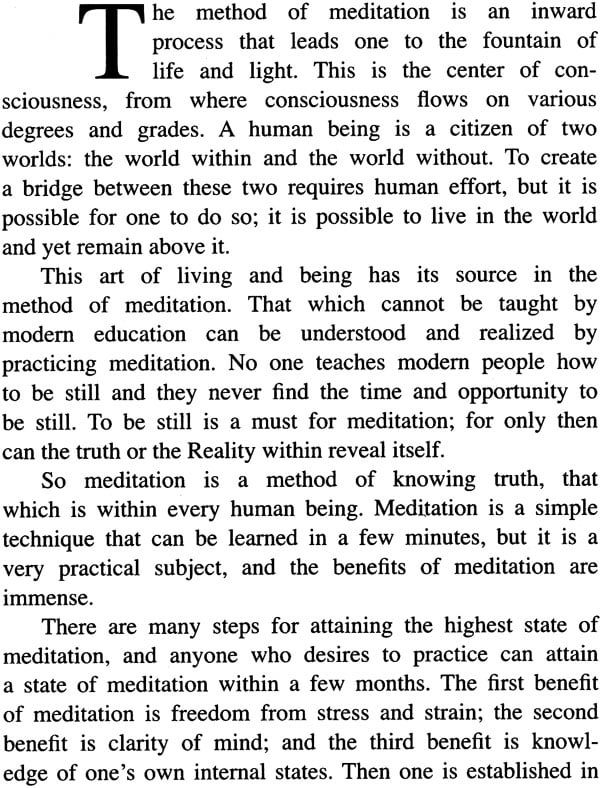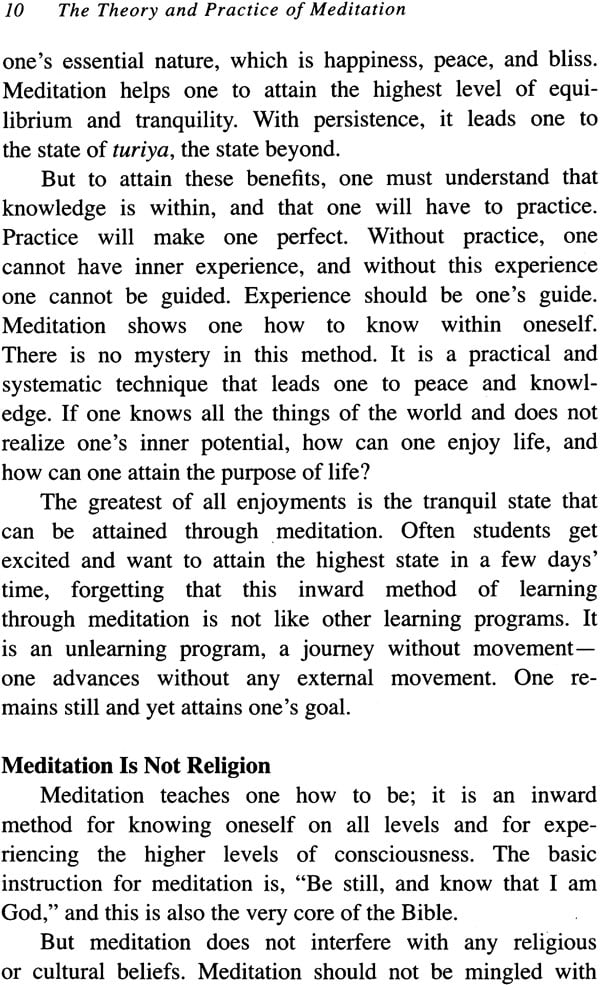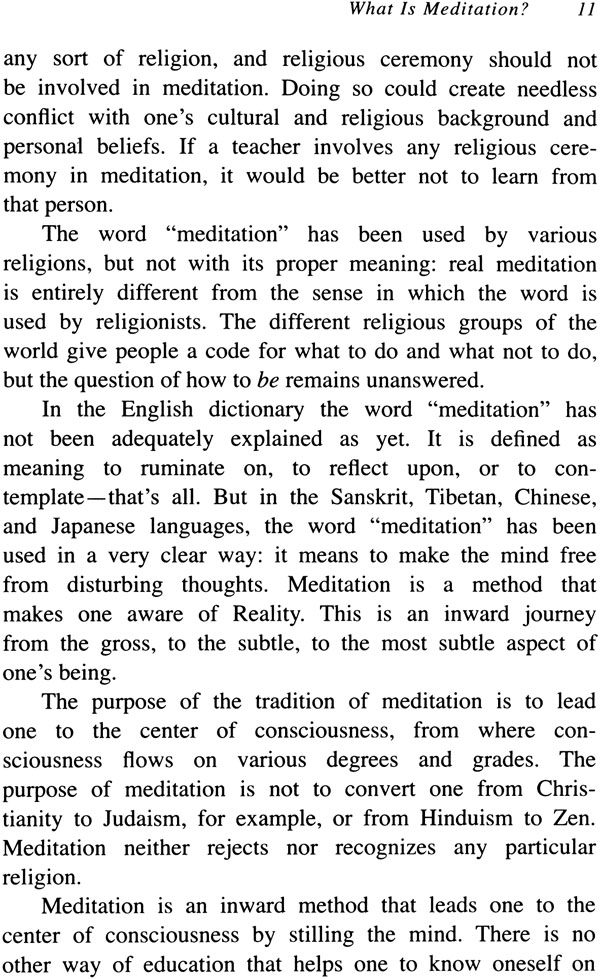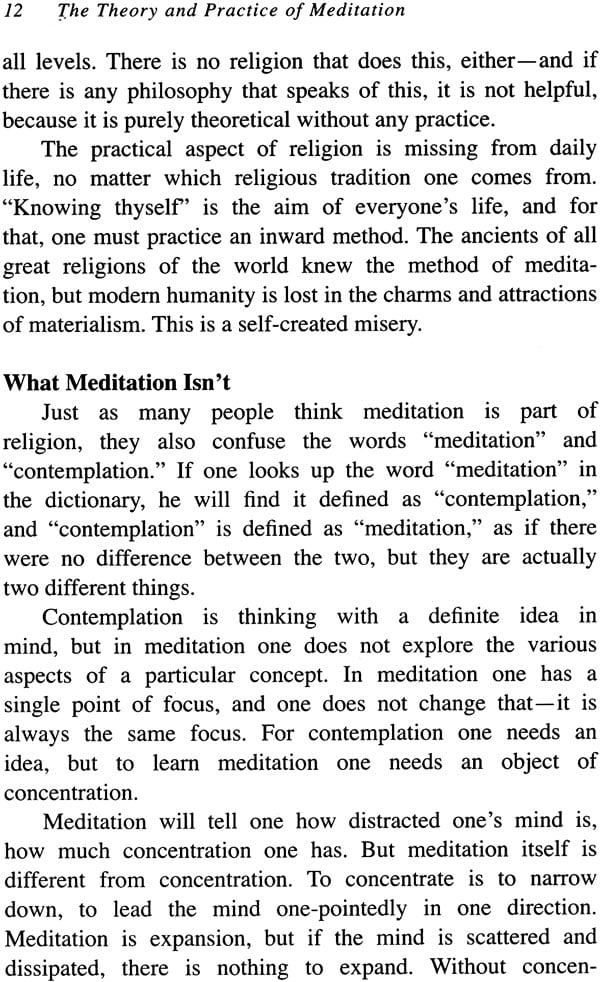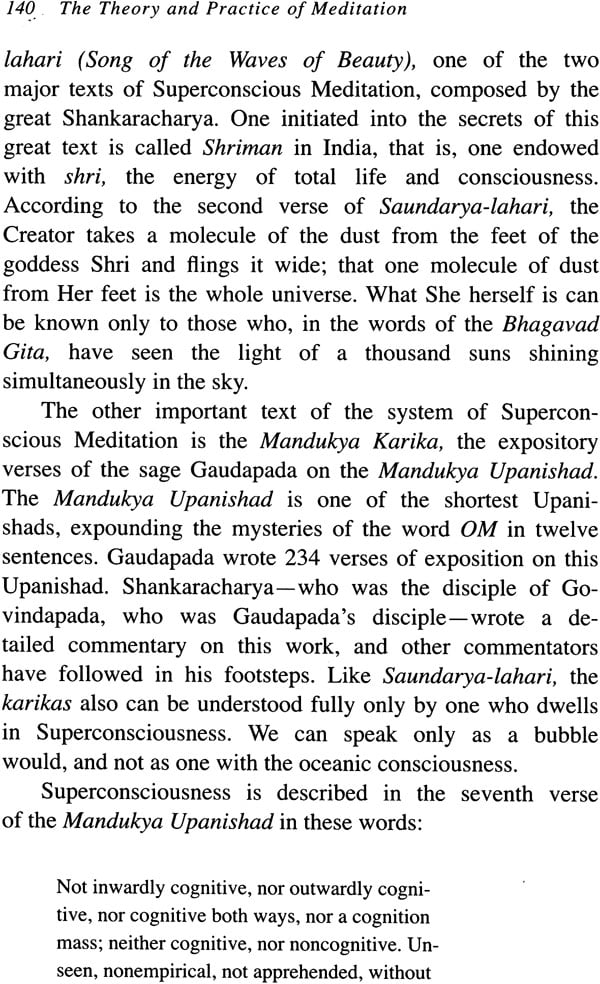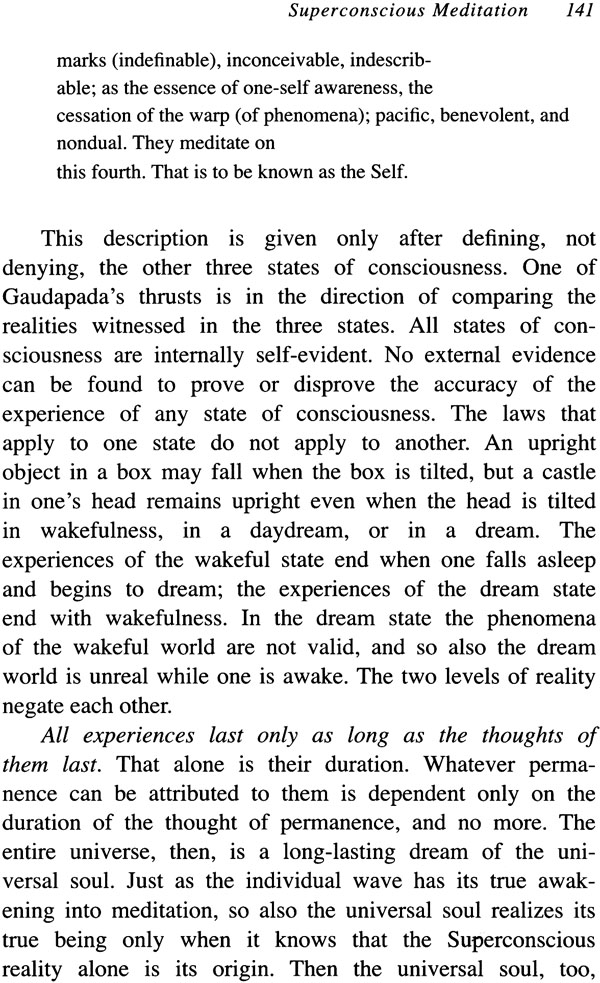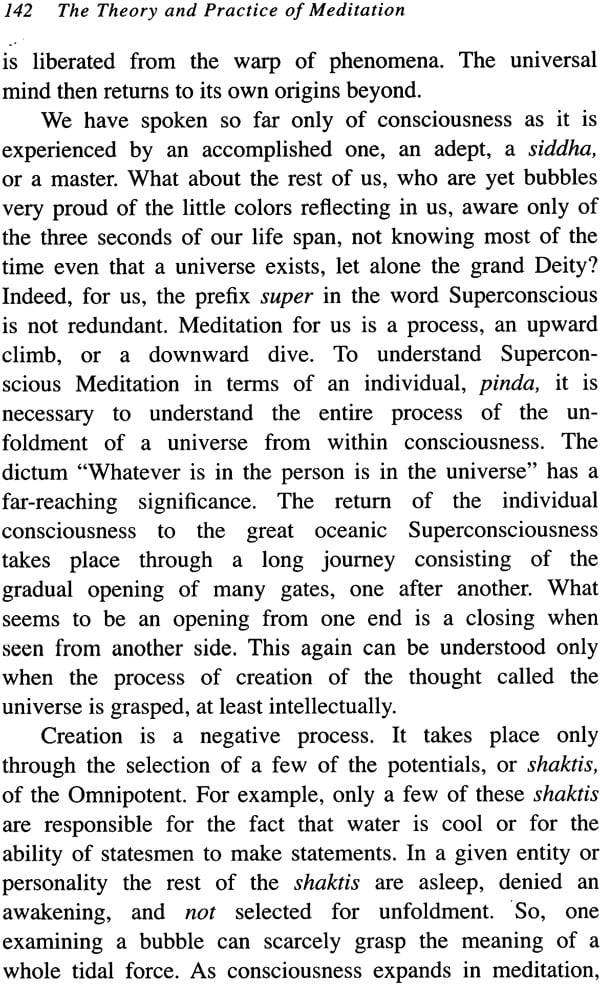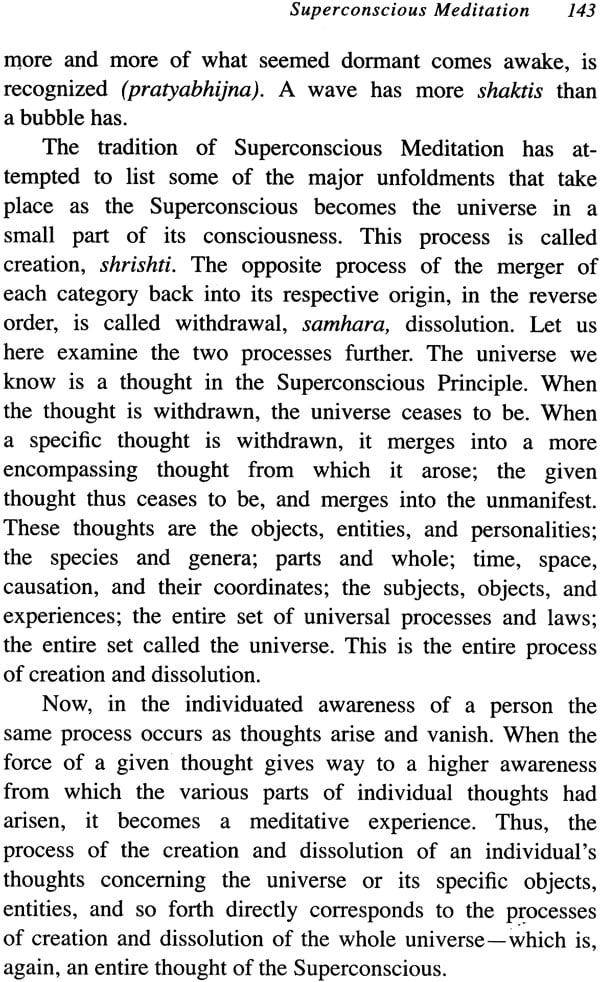
The Theory and Practice of Meditation (Second Edition, Revised and Expanded)
Book Specification
| Item Code: | NAE951 |
| Author: | Rudolph M. Ballentine, M.D |
| Publisher: | Himalayan International Institute of Yoga Science and Philosophy |
| Language: | English |
| Edition: | 1986 |
| ISBN: | 9780893890759 |
| Pages: | 174 |
| Cover: | Paperback |
| Other Details | 9.0 inch x 6.0 inch |
| Weight | 220 gm |
Book Description
“This book reflects the thought of some of the thought of some of the best-versed scholars and professional persons writing on yoga, Eastern thought, and meditation in the West today. The contributors to this volume are unique not only for their knowledge but also for their efforts to integrate the principles they have learned and thought into their own lives and work. Their writing have a freshness and simplicity that can come only from those who base their words on firsthand experience.
Together, the essays in his volume provide a well-rounded examination and explication of the nature and the process of meditation. This book is designed to provide the reader with a solid grounding in this vital art and science. This new edition of the Theory and Practice of Meditation has been extensively revised and expanded. We hope that it will be useful to both the beginning student and also those experienced students who want a deeper understanding of the practice of meditiation.”
Born in 1925 in northern India, Swami Rama was raised from early childhood by a great Bengali yogi and saint who lives in the foothills of the Himalayas. In his youth he practiced the various disciplines of yoga science and philosophy in the traditional monasteries of the Himalayas and studied with many spiritual adepts, including Mahatma Gandhi, Sri Aurobindo, and Rabindranath Tagore. He also travelled to Tibet to study with his grandmaster.
He received his higher education at Prayaga, Varanas, and Oxford University, England. At the age of twenty-four he became Shankarcharya of Karvirpitham in South India, the highest spiritual position in India. During this term he had a tremendous impact on the spiritual customs of that time; he dispensed with useless formalities and ritual, made it possible for all segments of society to worship in the temples, and encourages the instruction of women in meditation. He renounced the dignity and prestige of this high office in 1952 to return to the Himalayas to intensify his yogic practices.
After completing an intense meditative practice in the cave monasteries, he emerged with the determination to serve humanity, particularly to bring the teachings of the East to the West. With the encouragement of his master, Swami Rama began his task by studying Western philosophy and psychology. He worked as a medical consultant in London and assisted in parapsychological research in Moscow. He then returned to India, where he established an ashram in Rishikesh. He completed his degree in homeopathy at the medical college in Darbhanga in 1960. He came to the United States in 1969, bringing his knowledge and wisdom to the West. His teachings combine Eastern spirituality with modern Western therapies.
Swami Rama was a freethinker, guided by his direct experience and inner wisdom, and he encouraged his students to be guided in the same way. He often told them, “I am a messenger, delivering the wisdom of the Himalayan sages of my tradition. My job is introduce you to the teacher within.”
Swami Rama came to America upon the invitation of Dr. Elmer Green of the Menninger Foundation of Topeka, Kansas, as a consultant in a research project investigating the voluntary control of involuntary states. He participated in experiments that helped to revolutionize scientific thinking about the relationship between body and mind, amazing scientists by his demonstrating, under laboratory conditions, precise conscious control of autonomic physical responses and mental functioning, feats previously thought to be impossible.
Swami Rama founded the Himalayan International Institute of Yoga Science and Philosophy, the Himalayan Institute Hospital Trust in India, and many centres throughout the world. He is the author of numerous books on health, meditation, and the yogic scriptures. Swami Rama left his body in November 1996.
This book is a collection of articles by some of the best-versed scholars and professional persons writing on yoga, Eastern thought, and meditation in the West today. The contributors to this volume are unique not only for their knowledge but also for their sincere and thoroughgoing efforts to integrate the principles they have learned and taught into their own lives and work. This gives their writings a freshness and simplicity that can come only from those who base their words on firsthand experience.
Those who have accomplished to some degree an incorporation of the life of meditation into the fabric of their thought and work may find themselves overwhelmed by the simple question, “What is meditation?” How to describe something that is so simple in essence and yet so complex in its ramifications? Together, the essays in this volume provide a well-rounded examination and explication of both the nature and the process of meditation. This book is designed to provide the reader with a solid grounding in this vital art and science. This new edition of The Theory and Practice of Meditation has been extensively revised and expanded. We hope it will be useful both to the beginning student and also to those experienced students who want a deeper understanding of the practice of meditation.
The first article, “What Is Meditation?,” is written by Swami Rama. Though he has not attempted to establish a popular following either in his homeland or in the West, among the teachers of yoga and meditation in India he is regarded with respect and reverence. University-educated and appointed to the high post of Shankaracharya at an unprecedentedly young age, he left this position to carry the radiation of meditation to other parts of the world. Though the depth and breadth of his position to carry the tradition of meditation to other parts of the world. Though the depth and breadth of his knowledge is vast, Swami Rama here offers us a delightfully simple and yet surprisingly comprehensive description of both the aims and the means of meditation. As the first articles makes clear, meditation is an easy-to-learn inward method that, if consistently practiced, leads to a knowledge of oneself on all levels. As Swami Rama points out, the essence of yoga is the discovery and exploration of the world within oneself. The various practices of yoga are designed to prepare for and to facilitate this inner voyage. The article also describes six steps that lead one to the awareness of the inner reality and discusses the role played in this process by the personal teacher.
The next chapter, “Obstacles in Meditation,” explores the most common barriers of obstacles that individuals experience when they begin the practice of meditation. Experienced students may find it helpful in answering many questions about their experience. It indicates specific techniques to eliminate obstacles to one’s progress, so that one can enjoy the deepening experience of meditation without frustration or unnecessary difficulty.
In “Meditation in Action,” Swami Ajaya describes an approach to our daily lives that can make all our waking hours an extension of the meditative process. Far from being an escape from the world, meditation is a way of enhancing our ability to function in the world creatively, constructively, and peacefully. Swami Ajaya speaks from a unique vantage pont as both a swami and a practicing clinical psychologist, and his chapter describes the ways we can use meditation to live independently and joyfully.
As Dr. Phil Nuernberger points out in his articles, “Mind, Meditation, and Emotions,” the mind and emotions are major determining factors in health and disease. Emotional balance and harmony are the result of understanding ourselves on all level. Through meditation we develop our powers of internal concentration, and we become aware of our internal processes, leading to the ability to transform negative emotional states to the positive emotions of love, joy and tranquillity. As meditation deepens, we experience our true identity as one of calmness and monattachment, and we are able to be creative in the world without identifying with the ups and downs of our personalities or our previous attachments desires, and dependencies.
The next contributors, Dr. Arpita, write on the usefulness of meditation in coming to terms with basic issues of life. Trained in Western psychology, Dr. Arpita also has extensive experience in teaching the philosophy and psychology of the meditative tradition. Inner happiness, she reminds us, cannot be achieved without a sense of meaning and purpose in life. Meditation relives the core stress of human life; it is the effective and conscious way to solve the essential problem of spiritual unrest and emptiness.
The next article, entitled “Meditation and the Unconscious Mind,” explains how a systematic approach to meditation helps us to study the mind and to bring about a gradual expansion of consciousness and transformation of our personality. It examines the process by which our conscious mind is continuously functioning to maintain and reinforce our characteristic self-identity and explains how the practice of meditation can help us learn to identify with progressively higher and more expansive self-concepts. By becoming and uninvolved witness or a dispassionate observer to our habitual mental functioning, we allow our subconscious impressions to come into awareness and become integrated into our personality. The article then describes how meditation can help us create the conditions to reduce the ego’s defensiveness so that the process of observation can be facilitated and we can become actively involved in a process of ever-in-creasing psychic integration and self-realization.
The concluding article in this collection is a description of the tradition of Superconscious Meditation. The author, Dr. Usharbudh Arya, is a renowned Sanskrit scholar and pandit. In this essay he outlines for us the nature of the Superconscious, and relates the basic themes of the principal texts on which this tradition is based. He explains to us the simple yet revolutionary is based. He explains to us the simple yet revolutionary idea that consciousness forms the seed out of which the phenomenal world takes shape. This is both the essence of Eastern philosophy and the basis of Superconscious Meditation.
Finally, the Appendix systematically describe several of the specific breathing excercises that are referred to in these articles. As these writing make clear, the breathing exercises presented here constitute an important preparatory and preliminary part of meditation. A clear, concise introduction to the technique of meditation is also included.
The essay collected in this book deliberately range from the philosophical and poetic to the pragmatic and down-to-earth. For the questioning beginner, meditation is defined, described, and examined in terms of its philosophy, psychology, and techniques if allocation. By approaching the basic definition of meditation from several important perspective, the contributors to this volume have been able to offer the reader what is designed to be both the most comprehensive and the most practical introduction to the subject of meditation that is currently available.
| Introduction | 1 |
| What is Meditation? | 9 |
| Obstacles in Meditation | 35 |
| Meditation in Action | 49 |
| Mind, Meditation and Emotions | 67 |
| Meditation and Meaning in Life | 93 |
| Meditation and the Unconscious Mind | 109 |
| The Tradition of Superconscious Meditation | 135 |
| Appendix A : Breathing Exercises | 151 |
| Appendix B : Beginning the Practice of Meditation | 159 |
| About the Author | 163 |
